Building Stability Challenge
Developed by Tara Mollo, Playful Practicum 2022
People construct; one of the defining characteristics of humanity is that we make. We make structures (buildings, houses, schools, monuments), organizations, rules, ideas, and works of art.
The process of construction and design involves imagining and being inspired; asking questions; researching; planning and creating. Students will apply concepts of design principles to design and construct stable building structures.
Note: This lesson plan can be divided up over a course of a week or more.
Materials to gather
- A version of the book, “The Three Little Pigs”
- Reusable materials (i.e. paper towel tubes, tissue boxes, small boxes, plastic bottles, etc)
- Pencils
- Masking tape
- Scotch tape
- Glue (liquid or glue sticks)
- Tissue paper (assorted colors)
- String
- Yarn
- Popscicle sticks
- Children Blunt scissors
- Bowls/plates/trays to hold smaller materials (ie. cut up tissue paper, or smaller recycled materials).
- Plastic kid construction hats/ Paper Alternative Construction Hat with sentence strips
- Tool Apron (Alternative: Tool Belt with sentence strip)
- A “Talking Ball” (small ball/bean bag/stress ball, etc)
- Plastic cups for Pre-Set activities
- Hairdryer
Recommended Hand-outs:
- Design Journal
- Engineering Design Process Visuals
- Examples of Building Plans
- Buildings & Structures Around the World
- New Vocabulary Picture Cards
Set Up
- Clear students’ tables of other materials (ie workbooks, notebooks, etc).
- Have a materials table set up in the back of the classroom; have materials grouped together by classification (ie. paper towel tube, string, tape, etc).
- Have some materials pre-cut for students that may struggle with cutting; such as tape, string, yarn.
- Have some tissue paper cut into half, quarters or smaller pieces.
- Have hats and tool belts out; or have printed paper alternative precut for students to take, color, and write their name on them and sentence strips to staple them to.
- Have student Design Journals printed out and put together.
Since this lesson is designed to be completed in a course of a week or more. Have a safe area or table where teams can place their buildings while they are in between working on them.
Student’s Job
How can you construct a stable building out of reusable materials that is stable and can hold up to weather conditions (wind and earthquakes)?
Alternative scaffolded questions:
● How can you make a stable building out of reusable materials that is stable and can hold up to wind?
● How can you build a stable building out of reusable materials that is stable?
- (Day 1) Apr Pre-Set activity to develop team building. Introduce the concept of construction and sustainability under conditions by playing cup stacking video.
- Gather students back to whole-group to explain the Engineering Design Process to students. Use Engineering Process Visual Slideshow or print out slides for visuals for students.
- (Day 2) Post pictures of building structures from around the world for students; or display Building Structures from Around the World Slideshow. Whole-group have students analyze the structure photos. Discuss what they notice? What elements are making the structure stand and not fall?
- (Day 3) Explain the challenge to students. Tell them over the next week or more, they will be working as a team to design and build a stable building that can withstand wind and earthquakes. Hand out and review the Design Journal with the class. Tell students that today they will be completing Step 1 (imagine) in their journal. Have students begin to discuss as a team their ideas, documenting their plans in their Design Journal. Walk around the room and notice teams that have completed Step 1 in their journal. Call one team at a time to go over to the table of reusable materials to see what materials are available to use to construct their building. While teams are waiting for their turn they can color in the cover of their Design Journal and continue to discuss their ideas with their team.
- (Day 4) Post pictures around the room of different types of building blueprints for students; or show Examples of Building Blueprints Slideshow. Have students move around the room with their team to look at the building blueprints. They can circulate to music, like musical chairs. When the music stops, they have to stop at the blueprint closest to them and analyze it with their group.
- Have students begin to collaborate their ideas to their team to think about ideas of buildings.
- Have students begin to sketch out their building design in their Design Journal, on the Step 2 (plan) page.
- (Day 5) Explain to the students that they will now create a material list in their Design Journal, on Step 3 (create) page. Students can write or draw their material list of reusable materials they will need to construct their building; ensure them that they write the quantity of each item they will use. Remind students that they will be able to revise their material list once they test out their building design. They will be allowed to put back some materials or take additional needed materials.
- Have students gather their materials and begin to construct their buildings. Have students get into their role as construction workers/builders by wearing hard hats and tool belts. Explain to students that once they have finished constructing their building, they can test out their initial designs. Students can blow on their building and rock their table to see if it is stable. Once the team has completed their test run, they can complete Step 4 (experiment) in their Design Journal writing or drawing what happened. Explain to students if needed, they may revisit the reusable material table to gather more supplies if needed. Remind that they should write or draw new materials needed or their change in their building in their Design Journal, on Step 5 (improve) page.
- (Day 6) Once students have completed tested out their design, have students gather around their table. Allow each team to talk to the class about their design (materials used, why they used those materials, etc).
- Tell the class that it is time to see how stable their building is and whether or not it will withstand weather conditions; such as wind and earthquakes. Remind students that they should be respectful to one another. If one team’s building falls down or falls apart we should not laugh or make fun of them. Rather, we should encourage them and say things like “it’s okay” or “nice try”. Go around the classroom, one table at a time to test their building’s stability. Select one student from each team to use the hairdryer to see if the building holds up to the wind. The other teams can remain at their table, or they can stand around the team’s table to watch. Students watching can make howling noises like the wind (if needed teacher scaffolds wind noises. Remind students that they should not be making these noises in each other’s faces). Next, have the students at their team table shake their table a little to see if the building can hold up to earthquakes (remind students that they should not shake it too hard. Scaffold ato students how to shake the table appropriately). Do this for each team.
- (Day 7) Allow students to think and analyze why they think their building was or was not able to hold up to weather conditions.
- Using a talking ball, have students share their analysis and feedback for the other teams. .
Further Challenges:
After seeing whether or not their buildings held up to weather conditions. Have students go back to their plans and think how they can improve their design.
Teacher’s Job
Standards Alignment
Common Core Standards:
SPEAKING & LISTENING
Kindergarten.1: Participate in collaborative conversations with diverse partners about kindergarten topics and texts with peers and adults in small and larger groups.
Kindergarten.5: Add drawing or other visual displays to descriptions as desired to add additional detail
Next Generation Science Standards
MOTION AND STABILITY:
K-PS2-2: Forces and Interactions: Plan and conduct an investigation to compare the effects of different strengths or different directions of pushes and pulls on the motion of an object.
ENGINEERING DESIGN:
● K-2-ETS1-1 Ask questions, make observations, and gather information about a situation people want to change to define a simple problem that can be solved through the development of a new or improved object or tool.
● K-2-ETS1-2 Develop a simple sketch, drawing, or physical model to illustrate how the shape of an object helps iT function as needed to solve a given problem.
Prepare/ Background Info
- Read on of the versions of the “Three Little Pigs” stories to students.
- After reading the story, have a class discussion of how and why some of the pigs’ houses seem unstable and why they fell down.
- We have discussed how people chose building materials carefully. They consider the environment and the purpose of why they are building their structure.
Effective Facilitation Strategies
- Re-explain the challenge, and invite students to first talk to each other about how they might address it.
- Ask students/teams open-ended questions like:
- How does the Engineering Design Process help you as you work on your team’s structure?
- What do you notice in the photographs that helps you imagine your own building?
- What do you imagine you want to build?
- How are you choosing the types of materials to use for your structure?
- How are you collaborating?
- Encourage students to use the steps in the Engineering Design Process. Refer students to Engineering Design Process print out or anchor chart.
- Check in occasionally to see if students have questions or seem stuck.
Play to Notice
Experiential– Students will learn through hands-on exploration while building and making their project. Students will learn from their environment by interacting with real objects, choosing their own activity to complete, experimenting, making mistakes and trying again.
Physical– Students will work on fine motor skills while making and building their project; through cutting, pasting, painting, spreading, etc.
Social– With communications and interactions with each other will help assist students to use new vocabulary taught and promote discussions on their ideas while constructing their project.
Content Matter to Notice
Walk around while students are working; observe students and ask them open ended questions:
- What ideas do you have about solving this challenge?
- How can the design process help you as you work on this challenge?
- How can you test your ideas out?
- How will you work together to construct the best solution to this challenge?
- How does making a plan help you solve this challenge?
- What resources do you have to help you solve this challenge?
- Ask students to share their Design Journal with you.
SEL to Notice
SEL Relationship Skills: Teamwork

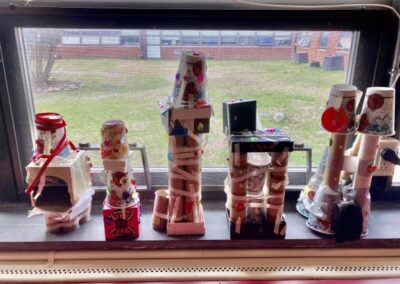
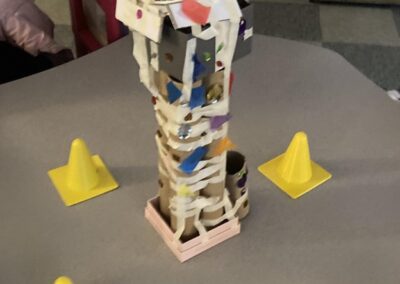
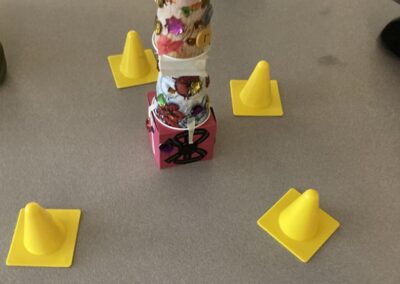
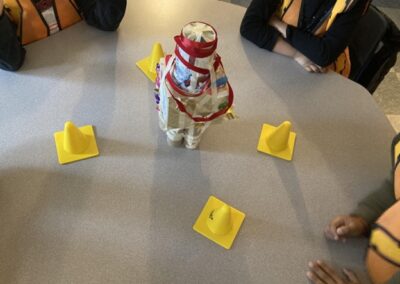
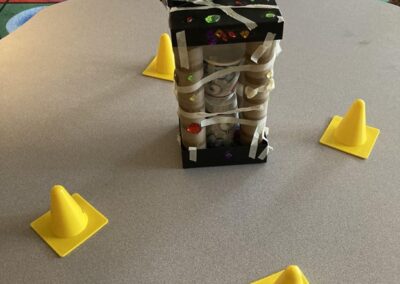

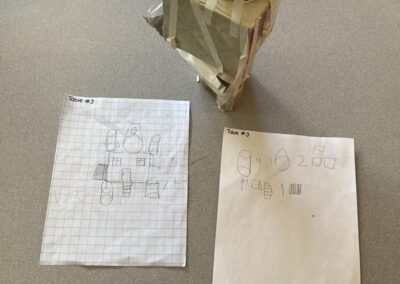
0 Comments